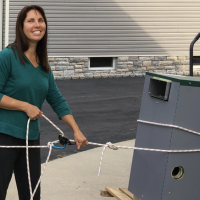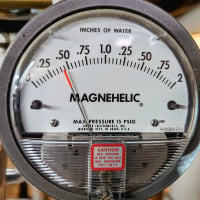Why not use fast vents on all radiators?
Other than the loud air sounds, are there any other downsides for not using fast vents on all radiators?
Comments
-
-
No two rooms will have the same heat requirement. There are two ways to adjust the heat provided by a radiator: with the size of the radiator itself, and with the vent. Not much one can do, easily, about the radiator size. That tends to be sort of fixed. But the vent? Ah yes. So to adjust the heating in a room to the use and taste of the occupants, one changes the vent size. Too hot? Try a slower vent. Too cool? Try a faster vent — but only after making sure that the rest of the venting in the building is more or less on.
Or, in short, if you make all the vents the same size and all fast, you will be guaranteed uneven heat.
Br. Jamie, osb
Building superintendent/caretaker, 7200 sq. ft. historic house museum with dependencies in New England1 -
I've also wondered this. Vents are relative to each other. So, using all Gorton D should give the same results as using all Gorton 4? I have Gorton D's on my 2 primary rads and slower vents on others. The vents are used to balance radiators.
0 -
There are several reasons for the old adage "vent mains quickly and vent radiators slowly".
In addition to the system balancing that vent selection accomplishes, vents also control the initial condensing rates of each radiator.
The most common complaints here is that of spitting and leaking radiator vents and water hammer. A cold radiator, filling with steam on a cold day condenses a bodacious amount of steam, creating a huge amount of condensate. With a huge vent, this happens nearly instantly. With steam rushing into the radiator at a quick velocity the exiting of condensate is impeded. The result is a waterlogged radiator and a vent spraying condensate. And water hammer as the steam and water meet.
A slower vent moderates the velocity of the steam entering the radiator, slowing the creation of condensate and facilitating its opposing exit from the radiator.
Depending on the system and the control settings, the slower vent helps negate water hammer, low boiler water, delayed condensate return, pissing vents and vile hydronic sounds.
On a generously designed system, however, with properly sized radiators handling a moderate load, very fast vents can be used successfully, and its owners can enjoy the economies of faster steam distribution.
As with most steam systems' details, vent sizing is a balancing act encompassing several factors.
5 -
I started off venting everything very slowly using all vent-rite #1s on my 15 radiators. They heated painfully slow. I swapped most of the vent-rites out for Maid-O-Mist adjustable vents and slowly increased the speed so that now nearly half of my radiators are using the D orifice. The rest being C or 6 and the bedrooms and bathrooms still have the vent-rites so I can turn them “off” when I want to.
I did notice some noise when I started venting faster. I thought it was hammer but it turned out to be expansion pings. This was completely solved by putting little pieces of milk jug under the radiator feet. Now the system is basically silent.
Just relaying my experience. I was afraid to vent fast because folks mostly discourage it but after trying it out it’s working really well for me.
0 -
I have a friend with all size D vents on every radiator. It works for her. But for most homes that would result in the steam just going wherever it wanted to, and not where you want it to, and would result in some overheated rooms and some cold rooms.
NJ Steam Homeowner.
Free NJ and remote steam advice: https://heatinghelp.com/find-a-contractor/detail/new-jersey-steam-help/
See my sight glass boiler videos: https://bit.ly/3sZW1el0 -
-
I colored outside the box in trying to get my system working. I added a MoM with no orifice installed on the valve side of the rads on the top ends of the runs, essentially acting as an accessory main vent. Steam will get to the near side of the rad ASAP, then after that vent closes, fill at the rate of the regular vent. I'd have done it by adding a tee to the spud pipe as I did to one, but on the others that would shove the rads obviously out of their positions below the windows.
3 -
Jells, you can drill and tap the vent boss on the inlet end of the radiator and put your additional vent there, if that's not what you did… It will serve to vent the runout to the radiator.
0 -
Thanks Ed, that is exactly what I did.
0
Categories
- All Categories
- 87.3K THE MAIN WALL
- 3.2K A-C, Heat Pumps & Refrigeration
- 61 Biomass
- 428 Carbon Monoxide Awareness
- 120 Chimneys & Flues
- 2.1K Domestic Hot Water
- 5.8K Gas Heating
- 114 Geothermal
- 166 Indoor-Air Quality
- 3.7K Oil Heating
- 77 Pipe Deterioration
- 1K Plumbing
- 6.5K Radiant Heating
- 395 Solar
- 15.7K Strictly Steam
- 3.4K Thermostats and Controls
- 56 Water Quality
- 51 Industry Classes
- 50 Job Opportunities
- 18 Recall Announcements






